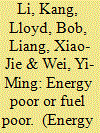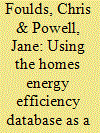|
|
|
Sort Order |
|
|
|
Items / Page
|
|
|
|
|
|
|
| Srl | Item |
| 1 |
ID:
133228


|
|
|
|
|
| Publication |
2014.
|
| Summary/Abstract |
Energy poverty and fuel poverty are descriptors of problems of households' energy consumption, they are both distinct problems and have been addressed by many researchers, organizations and governments. Cross use of the terms of energy poverty and fuel poverty in published papers is common. As an accurate descriptor is the presupposition of research and policy development, especially for those who just started to pay attention to this issue, this paper compares the definitions, research priorities, status quo, and problems of these two concepts, and summarizes the relationship between them. The paper suggests that only when the research targets are households who are living in a cold climate and have difficulty in getting access to electricity or modern cooking facilities, and in supplying indoor heating with appropriate cost, the concepts of energy poverty and fuel poverty have the chance to be broadened and mutually integrated.
|
|
|
|
|
|
|
|
|
|
|
|
|
|
|
|
| 2 |
ID:
150428


|
|
|
|
|
| Summary/Abstract |
This article focuses on residential energy consumption in France. Using a bottom-up statistical approach, this analysis explores determinants of household energy consumption using data from the most recent National Housing Survey. The primary objective is to tease out the impacts of various factors on the domestic energy consumption spectrum across different population groups. The aim of this approach is to neutralize conventional factors affecting energy consumption (age of house, total area, etc.) to finely analyze the impact of other determinants including those relating to household characteristics and other control variables.
First, we define homogeneous consumption groups of households by using multivariate statistical techniques, namely the Multiple Correspondence Analysis and Ascending Hierarchical Classification. Second, we use standard OLS regression to explore the effects of various factors on domestic energy consumption among homogeneous groups of households. This multivariate analysis exercise has led us to identify four main consumption typologies. Results revealed that energy prices were the most important factors determining domestic energy consumption. In addition, this study showed that occupant characteristics significantly affect domestic energy use. Results of this research call for combine all efforts, multiple strategies and smart policies, to incorporate household and consumption behaviors in managing domestic energy consumption.
|
|
|
|
|
|
|
|
|
|
|
|
|
|
|
|
| 3 |
ID:
132642


|
|
|
|
|
| Publication |
2014.
|
| Summary/Abstract |
In devising viable energy efficiency policies that can reduce the greenhouse gas emissions of existing dwellings (e.g. UK×s Green Deal), data are required on current insulation levels and its influences. One such data source is the seldom used UK Energy Saving Trust×s Homes Energy Efficiency Database (HEED), which this paper investigates using Norfolk UK local authorities as a case study. The HEED×s reactive and longitudinal data collection strategies contribute to underlying biases, which is the likely reasoning for its differences with the English Housing Survey and UK 2001 Census. These differences had a cascading effect in that they manifested themselves in the indicative financial and carbon assessments undertaken. Similarly, sampling concerns also implicated correlations surrounding influences of current dwelling insulation levels. Providing one is transparent about potential biases and data concerns, the HEED can play a substantial role in guiding policy decisions and understanding dwelling stock characteristics (e.g. what makes dwellings 'Hard to Treat×). In particular, its vast (national) geographic coverage yet high resolution enables local context to be explored: a factor that this study shows to significantly shape insulation levels.
|
|
|
|
|
|
|
|
|
|
|
|
|
|
|
|
|
|
|
|
|